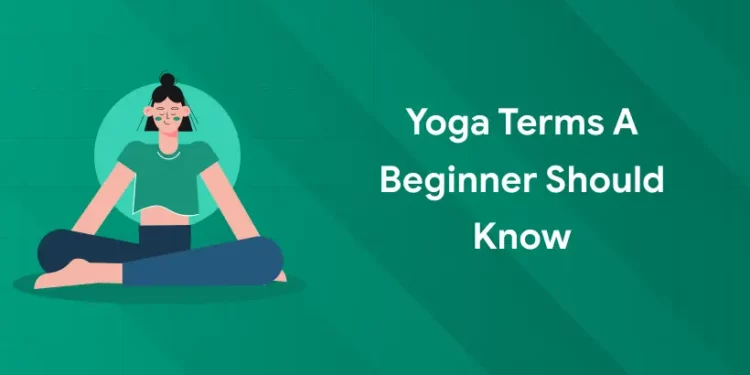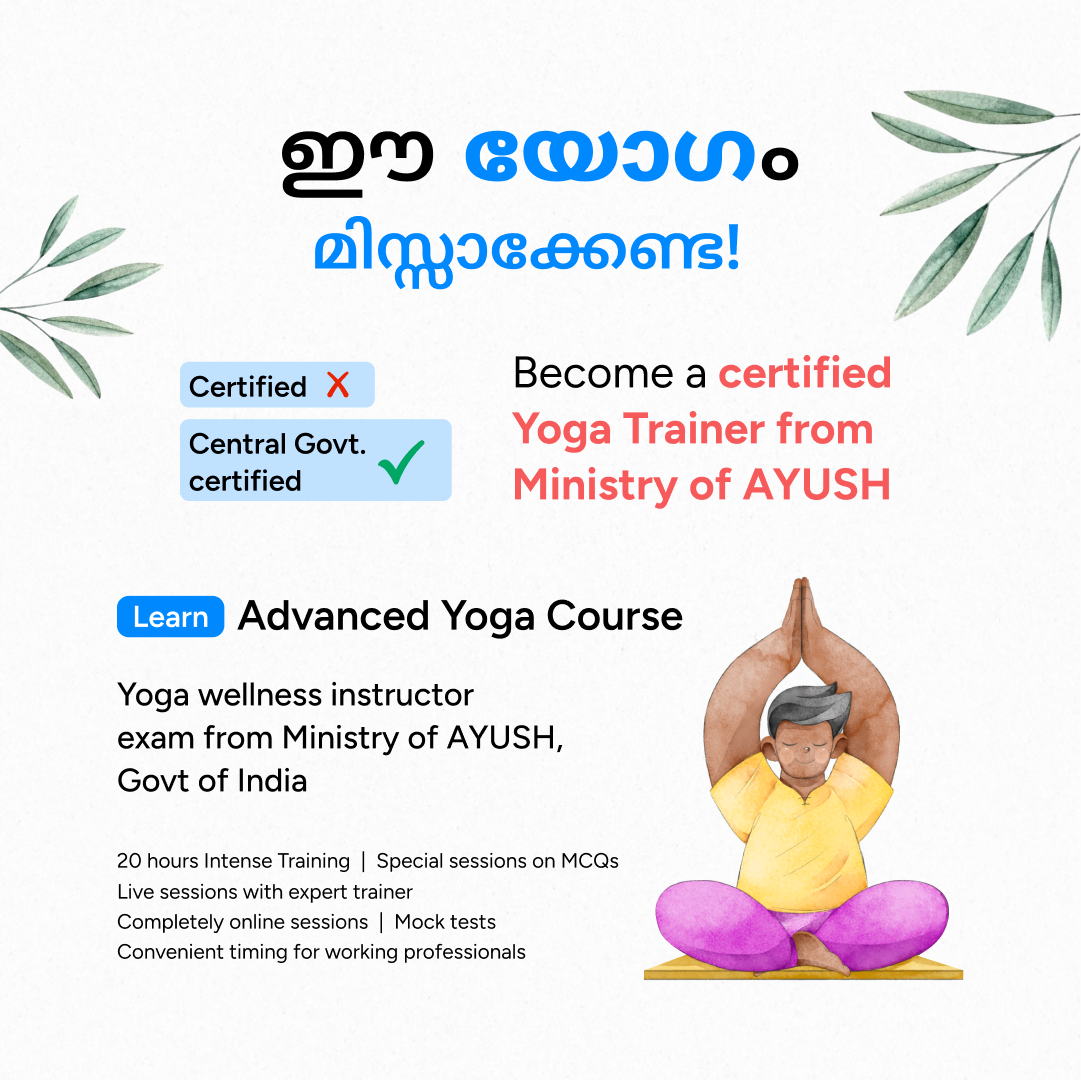Yoga is an extremely popular type of exercise, but it can be intimidating for beginners. Yoga is linked with a lot of jargon, and it can be challenging to remember all the words. Many of the poses have clear correlations with the language of yoga. Here is a glossary of some of the most popular Yoga Terms a Beginner Should Know to aid you on your path.
Learn Yoga Terms a Beginner Should Know from Experts! join Entri online Yoga classes!
Yoga Terms a Beginner Should Know
If you’ve ever taken a yoga class in person or virtually, you’ve undoubtedly heard some terminology that is a bit confusing. Expressions like “Adho Mukha Svanasana” and “chaturanga”. These are some of the terms and expressions from the ancient Sanskrit language. Sanskrit is considered to be one of the oldest human languages ever spoken. It is also the language of yoga and the foundation of many Indian languages.
It can be difficult to begin practising yoga. This is an examination of your body, mind, and spirit that will ultimately strengthen and deepen the connections between all three components. Why don’t we just begin with yoga terms a beginner should know? Let’s begin!
Want to get more into yoga? Join the Entri yoga classes today to learn from experts!
Yoga Terms a Beginner Should Know: Asanas
The term “asana” refers to the actual yoga poses, many of which offer a strenuous physical workout. Every posture serves a distinct function, such as aligning chakras to open energy pathways, stretching or strengthening muscles, or encouraging relaxation. Here is some yoga terminology that is specific to asanas to assist you get through your first session.
Downward Facing Dog
Adho Mukha Svanasana, also known as Downward Facing Dog, is a yoga pose that forms an upside-down “V” with the hips pointed toward the ceiling and the hands and feet apart.
Chaturanga or Chaturanga Dandasana
Low plank, sometimes called chaturanga dandasana, is a yoga pose. Chaturanga is a strength-building posture that stimulates your entire body as you lower halfway from a high plank position.
Warrior Pose
Another pose you’ll likely practice in a Vinyasa or Hatha yoga session is Warrior Pose, also known as Virabhadrasana. It resembles a high lunge when you extend your arms above your head and gently turn your rear foot out. Your arms extend out from your shoulders and your torso opens to the side in the Warrior II variant.
Corpse Pose
Most yoga courses end with poses known as savasana or corpse pose, which include lying flat on your back and closing your eyes. It’s a moment to unwind and integrate.
Sun Salutation
Sun Salutation, also known as Surya Namaskar, is a common Vinyasa yoga sequence that incorporates several of the aforementioned poses.
What is Namaste?
In some cultures, this word can be used as a salutation or a valediction. However, in yoga, you should usually say “namaste” (with your hands pressed together and your head bent) after the lesson.
“I bow to you” is the literal translation, but in a yoga class, that phrase has a different meaning. “The divine in me acknowledges the divine in you,” is what it says. However, in reality, it’s only a polite manner for the teacher and pupil to part ways.
Namaste is a phrase used in spirituality to recognize each other’s holiness and spirit. It suggests that everyone is divine and interconnected. It’s now considered a polite and meaningful way to close a yoga lesson in the lexicon of modern yoga.
What are Drishti Pointers?
The purpose of drishti, or focused gazing, is to bring awareness, intent, and attention to your yoga practice. In yoga, there are nine dishes, such as gazing at your toes, focusing on your navel, and looking upward. Your instructor will frequently point out where you should direct your eyes as you move through the asanas (yoga poses).
In yoga, there are various uses for a drishti. The main goal is to help you become self-aware while letting you retreat. Practising the appropriate drishti while meditation enhances concentration. Learning the correct drishti is also beneficial for maintaining balance and the ideal alignment of your body. In addition to reducing your chance of injury, you’ll maximize the benefits of your practice.
Yoga Terms a Beginner Should Know: Words from Sacred Texts
Many holy texts are giving us knowledge about yoga practises. Some words selected from these texts are listed below.
Yoga Sutras
Think of them as a guidebook for life in general and yoga practice.
Yama
The five yamas are described as ethical codes for living in the Yoga Sutras.
Guru
According to Patanjali, a guru is a spiritual mentor or teacher.
Mudra
A hand stance or gesture that allows the body to connect with itself. The goal of the action is to help the practitioner become more focused and connected.
Chakras
Seven wheels of energy are thought to be centred from the base of the pelvis to the top of the head along the spine.
Niyamas
This word refers to Rules, regulations, and guidelines. Five niyamas are listed in the Yoga Sutra: Tapas (self-discipline), Santosha (contentment), Saucha (cleanliness), Svadhyaya (self-reflection), and Ishvarapranidhana (surrender to a higher power).
Om or Aum
The sound produced during a yoga class chant. Om, which is frequently chanted, has several important connotations in yoga and represents the union of the mind, body, and spirit. It can also indicate the universe’s sound or all sounds together.
Prana
It represents life force or vitality. The sensation of growing strength in your muscles is called prana. You need to concentrate on your breathing patterns and bodily motions until they become one to focus and increase your prana.
Yoga Nidra
Yogic sleep is a technique for body renewal and relaxation that involves deep guided meditation. This technique induces a semi-conscious state, where the practitioner is aware of their surroundings but not fully awake.
Nadi
Channels in the body through which energy, or prana, flows. The strongest areas of connection in the body are said to be the chakras.
Shanti
The meaning of Shanti is Peace. During a yoga class or session, this is commonly sung three times to instil it both within and without.
Bandha
In Sanskrit, bandha signifies locked or closed. Although the term originally referred to obstructions in the prana (life force) flow of energy, it has come to mean four different kinds of bandha yoga poses, or asanas, which are locks or binds intended to assist in restoring the proper flow of energy for optimum health.
Yogi
A person who consistently performs yoga for an extended length of time is known as a yogi. It just states that a person is a dedicated yoga practitioner, not that they are an expert in the art.
Shala
A Shala is a designated area where individuals can come together to study, practice, and learn together. The terms “yoga studio” and “yoga space” are often used interchangeably. This kind of pavilion typically offers an open, shaded meeting space and is found in retreat facilities.
Ujjayi Breath
An everyday breathing exercise that raises blood oxygen levels, raises body temperature internally and keeps practice moving rhythmically. Make an open-mouth ‘HA’ sound to practice this technique. Try it once more while keeping your mouth shut. This is the Ujjayi breath. Known by this sound as the “oceanic breath” as well.
Dharana
Dharana, or “holding” or “concentration,” is the initial stage of meditation. This crucial component of meditation entails focusing intently on an object while making an effort to maintain mental stability at all times.
Get the best study materials to learn yoga! Join the entri app today!
Yoga Terms a Beginner Should Know: Koshas or Sheaths
This refers to different sheaths of the body. Annamaya, Pranamaya, Manomaya, Vijnanamaya, and Anadamaya are the five koshas in yoga.
Anandamaya Kosha
The bliss sheath, or Kosha, is the innermost sheath. It stands for unending happiness, love, and harmony.
Kosha Manomaya
The body’s third Kosha, or sheath. The mental layer, or Kosha, is concerned with ideas and feelings.
Annamaya Kosh
The primary and outermost sheath or Kosha of the body. Oftentimes called the gross body.
Pranamaya Kosha
The second of the body’s sheaths, or Koshas. This Kosha, which is typically connected to the breath, stands for the life force or energy force of the body.
Vijnanamaya Kosha
The fourth Kosha, or body sheath, is concerned with awareness, wisdom, and intuition.
What is a Mantra?
A mantra is a spoken word, phrase, or sound used in yoga that is used while chanting or meditation. Like a prayer, a mantra might be devoted to a particular deity. However, it might only be a single, straightforward syllable that is employed to direct attention and encourage a state of concentration.
The simplest mantra of all is probably Om, which you have undoubtedly heard before. Perhaps after a yoga practice, you even chanted it while holding your hands in the Anjali Mudra. This simple but powerful mantra contains all of the universe’s sounds in just one syllable!
Yoga Terms a Beginner Should Know: Yoga Styles
You may feel overwhelmed by the variety of classes available when perusing a yoga shala’s class schedule. You can use this short reference guide to determine which type of yoga is best for you.
Vinyasa Yoga
Also known as Vinyasa flow, this technique synchronizes movements and breathing. Vinyasa with a speciality following includes Power Yoga and Baptiste Yoga.
Hatha yoga
Hatha yoga is a conventional, frequently gentle kind of yoga that emphasizes breathing techniques and postures to develop harmony and balance in the body and mind.
Ashtanga
A disciplined and rigorous yoga technique that follows a predetermined sequence of poses.
Hot Yoga
Any form of yoga that is performed in a heated environment to promote flexibility. A particular kind of hot yoga is called Bikram Yoga.
Iyengar Yoga
This Yoga is named for B.K.S. Iyengar, who developed this specific yoga technique with an emphasis on spine alignment.
Restorative Yoga
Restorative yoga is a softer kind of yoga that encourages deep relaxation by employing props like blocks and blankets.
Yin Yoga
Yin yoga is a healing kind of yoga that concentrates on deep tissues like fascia and uses the body’s meridians, or energy pathways.
What is Pranayama?
This Sanskrit term describes breathing exercises or methods. Yama means “to control,” while prana is roughly translated as “life force.” Thus, pranayama is the practice of controlling your breathing with different techniques.
The initial purpose of pranayama, according to Richard Rosen, a yoga instructor since 1987, was to stabilize the breath to prepare the mind for meditation. When the teacher refers to pranayama in class, it means that everyone needs to pay attention to their breath. It’s simple to forget to breathe while everyone is maintaining a posture that requires focus.
Get the best teachers to learn yoga from! Click here to watch demo classes!
Yoga Terms a Beginner Should Know: Conclusion
All the important Yoga Terms a Beginner Should Know are mentioned in the article. You may learn more as you go. But never leave a new word without understanding. Consult yoga glossaries or ask your teacher if there are any doubts. Understanding the Yoga Terms a Beginner Should Know is an essential part of the yoga journey.
Become a Certified Yoga Instructor
Yoga Teacher Training Course by Entri App: Master authentic yoga techniques, earn certification, and build a successful career as a professional yoga instructor.
Join Now!Frequently Asked Questions
What should I do if in class I don't understand some yoga terms?
Never be afraid to ask your instructor to clarify any terminology you’re unclear on during class, or look them up afterwards to help you understand them better for upcoming exercises.
Is there a site for newcomers to learn yoga terminology?
Indeed! Many yoga studios include beginning lessons that concentrate on vocabulary. Online resources include in-depth glossaries and tutorials that can aid in acquainting you with the fundamental jargon used in yoga practice.
Can studying Sanskrit help me improve my yoga practice?
Of course! Although it’s not required, knowing Sanskrit can help you understand the concept and background of yoga better. It can improve your entire mat experience and help you feel more connected to the traditional origins of each pose.
What exactly is yoga?
Yoga is a traditional form of exercise that uses movement and meditation to connect the body and the breath. Although the practice has been established for around 5,000 years, it was more explicitly described in The Yoga Sutras, a yoga classic written by author Patañjali, between 400 and 500 BCE. The Sanskrit word yuj, which means to yoke, join, or combine, is the source of the word yoga. This is suggestive of the practice’s main goal of uniting the body, mind, and breath.
How to Practice Yoga Safely and Avoid Injuries?
Correct form and technique are vital for a safe and productive yoga practice. Consult your doctor before beginning any yoga practice if you have a history of illness. You can adjust yoga poses to suit your own needs.























